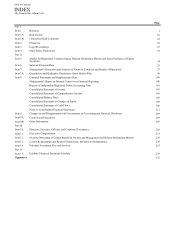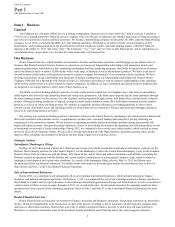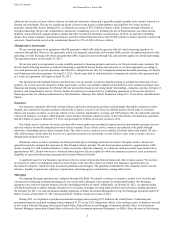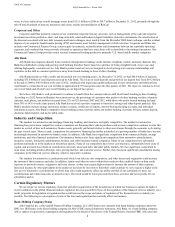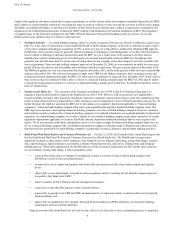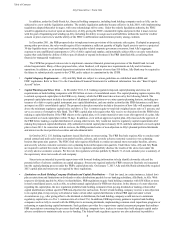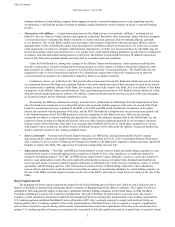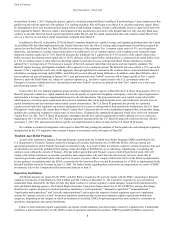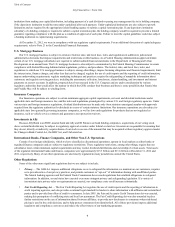Ally Bank 2012 Annual Report Download - page 8
Download and view the complete annual report
Please find page 8 of the 2012 Ally Bank annual report below. You can navigate through the pages in the report by either clicking on the pages listed below, or by using the keyword search tool below to find specific information within the annual report.6
In addition, under the Dodd-Frank Act, financial holding companies, including bank holding companies such as Ally, can be
subjected to a new orderly liquidation authority. The orderly liquidation authority became effective in July 2010, with implementing
regulations adopted thereafter in stages, with some rulemakings still to come. Under the orderly liquidation authority, the FDIC
would be appointed as receiver upon an insolvency of Ally, giving the FDIC considerable rights and powers that it must exercise
with the goal of liquidating and winding up Ally, including the ability to assign assets and liabilities without the need for creditor
consent or prior court review and the ability of the FDIC to differentiate and determine priority among creditors.
In December 2011, the FRB proposed rules to implement some provisions of the systemic risk regime. If adopted as proposed,
among other provisions, the rules would require Ally to maintain a sufficient quantity of highly liquid assets to survive a projected
30-day liquidity stress event and implement various liquidity-related corporate governance measures; limit Ally's aggregate
exposure to any unaffiliated counterparty to 25% of Ally's capital and surplus; and potentially subject Ally to an early remediation
regime that could limit the ability of Ally to pay dividends or expand its business if the FRB identified Ally as suffering from
financial or managerial weaknesses.
The CFPB has proposed various rules to implement consumer financial protection provisions of the Dodd-Frank Act and
related requirements. Many of these proposed rules, when finalized, will impose new requirements on Ally and its business
operations. In addition, as an insured depository institution with total assets of more than $10 billion, Ally Bank may be required in
the future to submit periodic reports to the CFPB, and is subject to examination by the CFPB.
• Capital Adequacy Requirements — Ally and Ally Bank are subject to various guidelines as established under FRB and
FDIC regulations. Refer to Note 21 to the Consolidated Financial Statements for additional information. See also “Basel Capital
Accord” below.
• Capital Planning and Stress Tests — In December 2011, U.S. banking regulators imposed capital planning and stress test
requirements on bank holding companies with $50 billion or more of consolidated assets. The capital planning regime requires Ally
to submit a proposed capital plan to the FRB every January, which the FRB must take action on by the following March. The
proposed capital plan must include a description of all planned capital actions over a nine-quarter planning horizon, including any
issuance of a debt or equity capital instrument, any capital distribution, and any similar action that the FRB determines could have
an impact on Ally's consolidated capital. The proposed action plan must also include a discussion of how Ally will maintain capital
above the minimum regulatory capital ratios and above a Tier 1 common equity-to-total risk-weighted assets ratio of 5 percent, and
serve as a source of strength to Ally Bank. The FRB's capital plan rule requires that Ally receive no objection from the FRB before
making a capital distribution. If the FRB objects to the capital plan, or if certain material events occur after approval of a plan, Ally
must submit a revised capital plan within 30 days. In addition, even with an approved capital plan, Ally must seek the approval of
the FRB before making a capital distribution if, among other factors, Ally would not meet its regulatory capital requirements after
making the proposed capital distribution. Ally submitted its initial capital plan in January 2012, and then submitted a revised capital
plan in June 2012. In connection with its reviews, the FRB provided notice of non-objection to Ally's planned preferred dividends
and interest on the trust preferred securities and subordinated debt.
In October 2012, U.S. banking regulators issued final rules on stress testing. The FRB final rule requires Ally to conduct semi-
annual (annual and mid-cycle) stress tests under baseline, adverse, and severely adverse economic scenarios over a planning
horizon that spans nine quarters. The FDIC final rule requires Ally Bank to conduct an annual stress test under baseline, adverse,
and severely adverse economic scenarios over a planning horizon that spans nine quarters. Under these rules, Ally and Ally Bank
are required to submit the results of these stress tests to regulators and publicly disclose the results of the stress tests under the
severely adverse economic scenario. Per the rule, the regulators will also publish, by March 31 of each calendar year, a summary of
the supervisory stress test results of each company.
Stress tests are intended to provide supervisors with forward-looking information to help identify downside risk and the
potential effect of adverse conditions on capital adequacy. Stress tests required under the FRB's stress test final rule are integrated
into the capital planning process under the FRB's capital plans rule. On January 7, 2013, Ally and Ally Bank submitted the required
2013 capital plan and stress tests as required by these regulations.
• Limitations on Bank Holding Company Dividends and Capital Distributions — Utah law (and, in certain instances, federal law)
places restrictions and limitations on dividends or other distributions payable by our banking subsidiary, Ally Bank, to Ally. With
respect to dividends payable by Ally to its shareholders, FRB regulations require bank holding companies with $50 billion or more
in total consolidated assets, such as Ally, to submit annual capital plans for FRB non-objection. In the absence of a non-objection
regarding the capital plan, the new regulation prohibits bank holding companies from paying dividends or making certain other
capital distributions without specific FRB non-objection for such action. Even if a bank holding company receives a non-objection
to its capital plan, it may not pay a dividend or make certain other capital distributions without FRB approval under certain
circumstances (e.g., after giving effect to the dividend or distribution, the bank holding company would not meet a minimum
regulatory capital ratio or a Tier 1 common ratio of at least 5%). In addition, FRB supervisory guidance requires bank holding
companies such as Ally to consult with the FRB prior to increasing dividends, implementing common stock repurchase programs or
redeeming or repurchasing capital instruments. Such guidance provides for a supervisory capital assessment program that outlines
FRB expectations concerning the processes that bank holding companies have in place to ensure they hold adequate capital under
adverse conditions to maintain ready access to funding. The federal bank regulatory agencies are also authorized to prohibit a
Table of Contents
Ally Financial Inc. • Form 10-K


